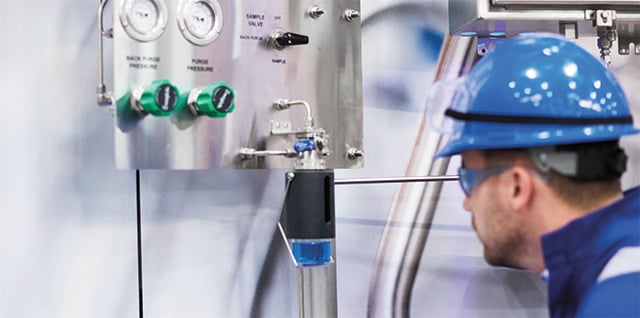Share this
Choosing an Industrial Gas Sampling Point in Legacy Refineries
by Morgan Zealear on 11/18/21 9:00 AM

Legacy industrial refineries often undergo retrofitting to improve efficiency and safety. An area to consider retrofitting that improves both efficiency and safety is an upgrade in gas sampling. Gas sampling indicates the composition of chemicals in processing which may point to issues that are related to production efficiencies such as leaks, unintended side-reactions, and contaminants entering the system. Identifying and correcting these issues also improves safety for operators as they may prevent damage to components that lead to leaks and exposure to chemicals.
While this is an important process for meeting safety and production standards, there are several issues that can occur while gas sampling. These issues may make sample data inaccurate or may not provide a whole picture of what is occurring during processing.
This article will discuss the challenges that may arise during gas sampling with a specific focus on the sampling points and reasons for sampling variability.
Difficulties in Gas Sampling for Legacy Refineries
Gas sampling plays an important role for the continued efficient operation of a refinery. However, gas sampling may be problematic if sample variability does not provide the whole picture of the composition of the gas. There are several reasons for this variability in sampling.
Sample Point Variability
Perhaps the most significant problem with getting an accurate analysis of a gas is sample point variability. Samples can be collected at the well head, separator outlet, stock tank, and pipeline terminal, and at several locations from the terminal to the refinery gate.
It is recommended to sample along many points of the refinery process. Crude oils undergo changes in properties as they progress along the supply chain. At any of these points, an unintended side reaction or change could occur.
Legacy refineries may have issues with sampling in many of these locations due to existing infrastructure limiting space for sampling systems. In addition, these locations may experience differences in ambient temperatures and pressures, which may cause inaccurate sampling.
The Influence of Variable Operating Conditions on Sample Point Variability
Variations in temperature and pressure may result in differences in sampling as certain molecules of the gas mixture may respond differently to these conditions. During condensation, for example, a molecule’s response to these conditions may result in more or less of that molecule reaching the sensor (for active or passive sampling) or gas collection chamber (in the case of grab sampling), causing the sample to inaccurately indicate the gas composition. In addition, the time of the sampling may incur a different result in sampling as the upstream processes from the sampling location may be undergoing different processing.
Legacy refineries—with a conglomerate of components from past updates and retrofitting—may experience more of these issues as the sensor locations in the processing system may be limited based on existing infrastructure rather than where they obtain the most accurate sample.
These refineries can update existing equipment and utilize sampling strategies to get a more accurate sample, monitor gas, prevent leaks, and keep operators safe.
Updating Legacy Refinery Components for Gas Sampling
Several components used for gas sampling can be updated in a legacy refinery to help improve sampling accuracy. These components are dependent on the type of sampling utilized and the existing infrastructure.
Type of Gas Sampling Implemented
The type of gas sampling used—active, passive, or grab sampling—is determined based on how different molecules react to changes in pressure and temperature. An active sampling method that utilizes pumps to make sure all molecules of the gas are sampled might be preferred over a passive sampling method that analyzes the composition of gases as they pass over a sensor (with gas density potentially causing issues for which gas contacts the sensor). Because grab sampling only gives a snapshot of the gas sampled at that specific time, it should be performed at regular intervals to account for the variation in downstream processing.
Existing Infrastructure
The existing infrastructure—such as limited space—may also influence the type of sampling used and the locations throughout processing which would work for gas sampling in legacy refineries. In addition, gas sampling could be utilized around areas of concern (e.g. areas with the biggest risks of leakage) to add an additional layer of protection in case problems occur.
Ancillary Components for Gas Sampling
The components needed for gas sampling are directly related to the type of gas sampling used which is related to the point location and limitations of existing infrastructure. The type of gas sampling used would determine if pumps, sensors, or collection cylinders are needed for gas sampling and analysis. In addition, the gas composition would influence the tubing and material characteristics for these components.
An expert can help with retrofitting a legacy refinery to determine gas sampling methods and gas sampling needs.
Expert Consultation to Help You Choose an Industrial Gas Sampling Point
Accurately sampling gases is critical for determining if refineries are operating at peak efficiency. By consulting with an expert, your specific gas sampling needs can be determined based on existing conditions and infrastructure.
Swagelok has experts that can examine a retrofitted refinery’s blueprints to determine the optimal point locations for gas sampling. They will also be able to suggest the necessary upgrades to components for sampling to provide accurate data on gas composition.
Swagelok Northern California has worked extensively with local refineries to achieve reliable and consistent sampling. Our Field Engineers have extensive knowledge of gas sampling applications in refineries and can provide onsite consultations to determine the ideal gas sampling point for your legacy refinery.
To learn more about how Swagelok Northern California can help you with your gas sampling needs, contact our team today by calling 510-933-6200.
 Morgan Zealear | Product Engineer – Assembly Services
Morgan Zealear | Product Engineer – Assembly Services
Morgan holds a B.S. in Mechanical Engineering from the University of California at Santa Barbara. He is certified in Section IX, Grab Sample Panel Configuration, and Mechanical Efficiency Program Specification (API 682). He is also well-versed in B31.3 Process Piping Code. Before joining Swagelok Northern California, he was a Manufacturing Engineer at Sierra Instruments, primarily focused on capillary thermal meters for the semiconductor industry (ASML).
Share this
- Archive (465)
- Assembly Services (207)
- About (100)
- Seal Support Systems (96)
- Best Practices (88)
- Training Services (74)
- Fittings (51)
- Semiconductor Applications (49)
- Hoses and Flexible Tubing (47)
- Regulators (44)
- Tubing (42)
- Grab Sampling Systems (32)
- Sampling Systems (32)
- Gas Systems (30)
- Services (30)
- Downloads (29)
- Valves (24)
- Application Support (18)
- Orbital Welding (17)
- Case Studies (13)
- Steam Systems (13)
- Frequently Asked Questions (12)
- Tools (12)
- Measurement Devices (7)
- Subsystems (6)
- Thermal Management (6)
- September 2023 (1)
- August 2023 (2)
- June 2023 (1)
- March 2023 (3)
- February 2023 (3)
- January 2023 (4)
- December 2022 (4)
- November 2022 (4)
- October 2022 (4)
- September 2022 (1)
- August 2022 (3)
- July 2022 (2)
- June 2022 (4)
- May 2022 (1)
- April 2022 (2)
- March 2022 (1)
- February 2022 (2)
- January 2022 (3)
- December 2021 (1)
- November 2021 (6)
- October 2021 (6)
- September 2021 (8)
- August 2021 (4)
- July 2021 (3)
- June 2021 (6)
- May 2021 (6)
- April 2021 (7)
- March 2021 (5)
- February 2021 (4)
- January 2021 (6)
- December 2020 (5)
- November 2020 (6)
- October 2020 (6)
- September 2020 (8)
- August 2020 (7)
- July 2020 (8)
- June 2020 (8)
- May 2020 (6)
- April 2020 (9)
- March 2020 (7)
- February 2020 (10)
- January 2020 (21)
- December 2019 (23)
- November 2019 (21)
- October 2019 (22)
- September 2019 (21)
- August 2019 (22)
- July 2019 (23)
- June 2019 (20)
- May 2019 (23)
- April 2019 (22)
- March 2019 (21)
- February 2019 (20)
- January 2019 (21)
- December 2018 (14)
- November 2018 (19)
- October 2018 (23)
- September 2018 (17)
- August 2018 (29)
- July 2018 (11)
- June 2018 (6)
- May 2018 (5)
- April 2018 (4)
- March 2018 (5)
- February 2018 (3)
- January 2018 (3)
- December 2017 (2)
- November 2017 (4)
- October 2017 (3)
- September 2017 (2)
- August 2017 (6)
- July 2017 (4)
- June 2017 (4)
- May 2017 (4)
- April 2017 (3)
- March 2017 (4)
- February 2017 (3)
- January 2017 (3)
- December 2016 (3)
- November 2016 (3)
- October 2016 (3)
- September 2016 (5)
- August 2016 (5)
- July 2016 (4)
- June 2016 (5)
- May 2016 (3)
- April 2016 (4)
- March 2016 (5)
- February 2016 (11)
- January 2016 (1)
- December 2015 (3)
- November 2015 (4)
- October 2015 (3)
- September 2015 (4)
- August 2015 (4)
- July 2015 (8)
- June 2015 (5)
- May 2015 (3)
- April 2015 (4)
- March 2015 (4)
- February 2015 (3)
- January 2015 (4)
- December 2014 (2)
- November 2014 (3)
- October 2014 (4)
- September 2014 (4)
- August 2014 (4)
- July 2014 (5)
- June 2014 (4)
- May 2014 (4)
- April 2014 (5)
- March 2014 (4)
- February 2014 (3)
- January 2014 (4)
- December 2013 (5)
- November 2013 (3)
- October 2013 (4)
- September 2013 (3)
- August 2013 (5)
- July 2013 (5)
- June 2013 (5)
- May 2013 (3)
- April 2013 (6)
- March 2013 (4)
- February 2013 (4)
- January 2013 (8)
- December 2012 (4)
- November 2012 (6)
- October 2012 (6)
- September 2012 (4)
- August 2012 (4)
- July 2012 (4)
- June 2012 (4)

.webp?width=210&height=70&name=StickyLogo%20(5).webp)